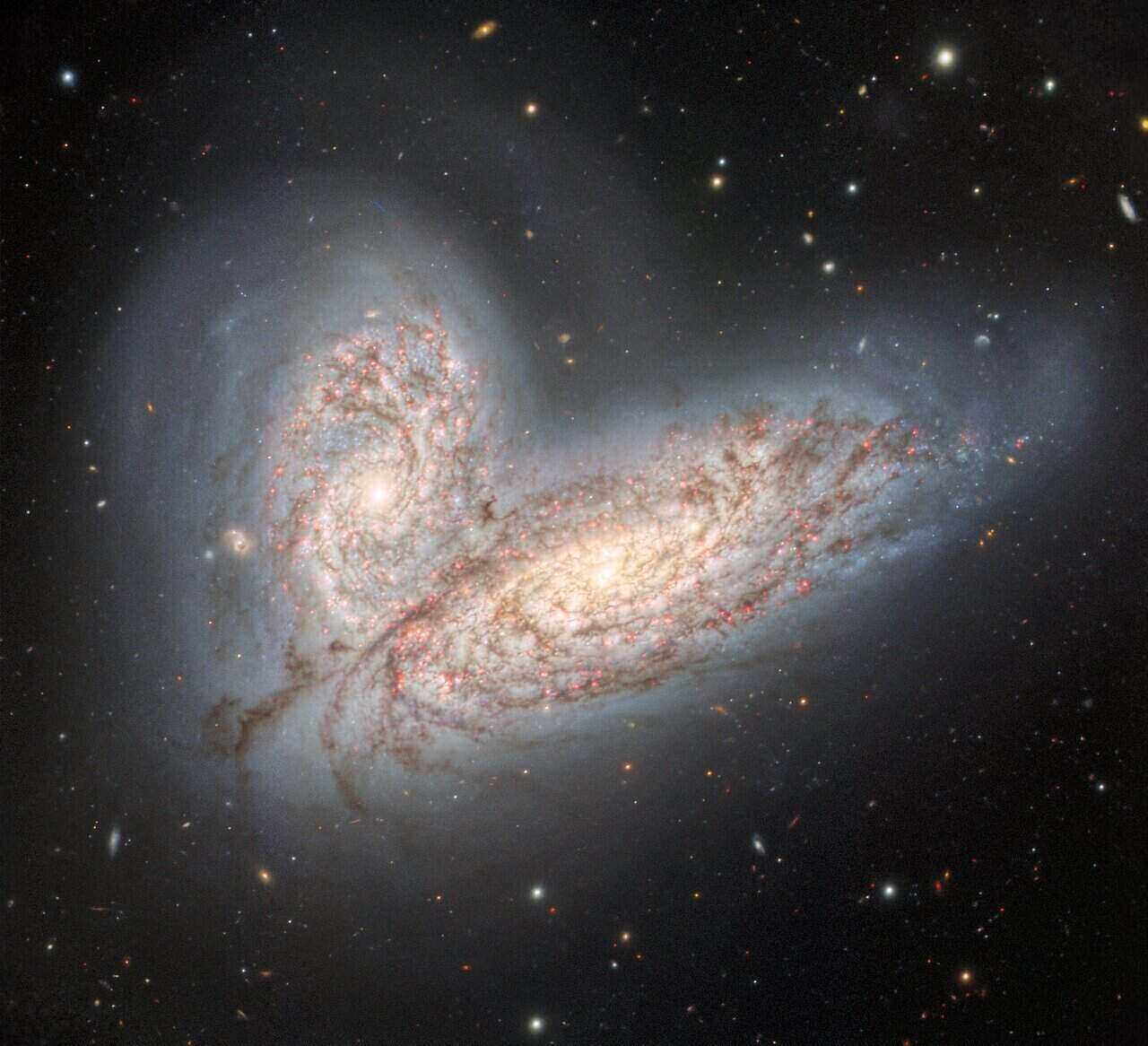In the vast expanse of the cosmos, where countless galaxies dance to the rhythm of gravitational forces, there exists a celestial masterpiece that captivates astronomers and stargazers alike – the Butterfly Galaxies NGC 4567 and NGC 4568. Situated in the Virgo Cluster, these twin galaxies showcase the cosmic ballet that unfolds over millions of years, creating a mesmerizing display of beauty and scientific intrigue.
Discovery and Classification
The Butterfly Galaxies were first discovered by British astronomer Sir William Herschel in the late 18th century. NGC 4567 and NGC 4568 are classified as spiral galaxies, a common but enchanting cosmic structure characterized by a central bulge surrounded by spiral arms adorned with bright stars, gas, and dust. The unique nickname “Butterfly” was coined due to their distinct appearance resembling the delicate wings of these graceful insects.
Location in the Cosmos
These celestial gems are located approximately 60 million light-years away in the Virgo Cluster, a massive collection of galaxies bound together by gravity. The Virgo Cluster is one of the nearest galaxy clusters to our own Local Group, making it a focal point for astronomers studying the dynamics and interactions of galaxies in the universe.
Physical Characteristics
The Butterfly Galaxies share some common physical characteristics, but they also exhibit unique features that contribute to their allure. NGC 4567 and NGC 4568 each span tens of thousands of light-years, with intricate spiral arms that gracefully wind around their galactic centers. The bright blue hues in their spiral arms signify regions of active star formation, where massive, hot, young stars illuminate the cosmic landscape.
Interacting Galaxies
What sets the Butterfly Galaxies apart from other celestial duos is their ongoing interaction. Gravity, the invisible force that governs the cosmos, plays a significant role in shaping the destiny of galaxies. The gravitational forces between NGC 4567 and NGC 4568 have led to a complex dance of interaction, creating tidal tails and bridges of stars and gas that connect the two galaxies.
The tidal tails, elongated streams of material extending into space, are a testament to the gravitational forces at play. As the galaxies interact, they exchange matter, triggering bursts of star formation and influencing the evolution of their respective structures. These interactions provide astronomers with a unique opportunity to study the processes that shape galaxies over cosmic timescales.
Stellar Nurseries and Star Formation
The vibrant blue regions within the spiral arms of the Butterfly Galaxies are indicative of stellar nurseries – areas where gas and dust collapse to form new stars. The gravitational interactions between NGC 4567 and NGC 4568 compress the interstellar material, creating conditions conducive to the birth of massive, luminous stars.
These newly formed stars contribute to the overall brilliance of the galaxies and play a crucial role in enriching the cosmic landscape with heavy elements. The study of star formation in interacting galaxies, such as the Butterfly Galaxies, provides valuable insights into the mechanisms that drive the evolution of galaxies across the universe.
Morphological Evolution
The Butterfly Galaxies offer astronomers a front-row seat to witness the morphological evolution of galaxies. The ongoing interaction between NGC 4567 and NGC 4568 is a dynamic process that influences their shapes, structures, and overall appearances. Understanding the impact of these interactions on galactic morphology is essential for unraveling the mysteries of galaxy evolution.
Computer simulations and observational studies of interacting galaxies contribute to our comprehension of the intricate dance of cosmic forces that shape the destinies of celestial bodies. The Butterfly Galaxies, with their captivating appearance and ongoing interaction, serve as a natural laboratory for studying the morphological evolution of galaxies in the vast cosmic theater.
A Stellar Spectacle for Observers
For amateur and professional astronomers alike, the Butterfly Galaxies offer a spectacular sight in the night sky. Observing these celestial gems through telescopes reveals intricate details of their spiral arms, bright star clusters, and the subtle interplay of light and shadow on their surfaces.
Astrophotographers also find the Butterfly Galaxies to be captivating subjects, capturing long-exposure images that unveil the intricate details of their cosmic dance. These images not only showcase the aesthetic beauty of the galaxies but also provide valuable data for scientific analysis.
The Future of Butterfly Galaxies Research
As technology advances and observational instruments become more powerful, astronomers continue to uncover new facets of the Butterfly Galaxies. Ongoing studies aim to delve deeper into the physical processes at play during their interaction, exploring the distribution of dark matter, the dynamics of gas flows, and the role of magnetic fields in shaping their evolution.
Future space missions, such as the James Webb Space Telescope, promise to provide unprecedented insights into the Butterfly Galaxies and other cosmic wonders. The combination of advanced observational capabilities and sophisticated computer simulations will enhance our understanding of the underlying physics driving the evolution of these celestial ballet dancers.
Conclusion
NGC 4567 and NGC 4568, the Butterfly Galaxies, stand as a testament to the dynamic and captivating nature of the cosmos. Their ongoing interaction, intricate spiral arms, and vibrant star-forming regions make them a celestial spectacle that beckons astronomers and stargazers to gaze into the depths of the universe.
As our understanding of galaxy interactions and evolution continues to evolve, the Butterfly Galaxies remain a source of inspiration and scientific inquiry. Their beauty serves as a reminder of the cosmic dance that shapes the galaxies in our vast and mysterious universe, inviting us to explore the wonders that lie beyond our terrestrial home.

Leave a Reply